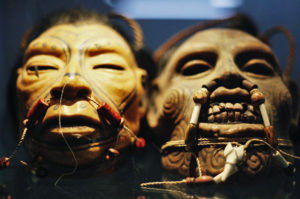Patagotitan — like Paddington Bear — is a creature from South America with a name that identifies where it was found. Patagonia, the region that encompasses the southernmost reaches of Argentina and Chile, is a land so vast and empty that Welsh colonists, back in the 19th century, identified it as the one stretch of open country in the world likely to have been left “uncontaminated by Englishmen”. They were not the first to believe extraordinary things of its mountains, lakes and deserts. Ever since Ferdinand Magellan rounded South America while making the first circumnavigation of the world, back in 1520, Europeans have been prone to imagining fantastical things of Patagonia.
And in particular to imagining it a land of giants. Magellan himself had seen a naked colossus singing and dancing on its shore — “so tall that the tallest of us only came up to his waist”. Bruce Chatwin, author of the most famous account in English of Patagonia, had once, as a child, admired a piece of skin from the region kept by his grandmother in a glass-fronted cabinet. His mother had told him that it belonged to a Brontosaurus. Inspired by this memory to travel there, he visited a lake where a Plesiosaurus was reported to lurk. A Texan adventurer, camping beside its waters in 1922, had observed the creature’s head protruding from its depths. “At first sight it was like some unknown species of swan, but swirls in the water made me think its body must resemble a crocodile’s.”
None of these reports, alas, was true. Francis Drake, observing the natives of Patagonia, dismissed Magellan’s reports of their enormous size as a typically Spanish exaggeration: “for they are nothing so monstrous and giant-like as they were represented, there being some English men as tall as the highest we could see, but peradventure the Spaniards did not think that ever any English man would come hither to reprove them, and therefore presume the more boldly to lie”. The piece of hide owned by Bruce Chatwin’s grandmother turned out to have belonged, not to a Brontosaurus, but to a sloth. Of the Plesiosaurus, not a trace was ever found. Chatwin, standing beside the lake where the Texan had reported seeing it, marvelled that anyone should for a moment have believed in its existence. “And with the plesiosaurus died the hope of finding, in Patagonia, live dinosaurs like those described by Conan Doyle, stranded on their plateau in The Lost World.”
And yet Patagonia, for all that, had indeed been home to giants. “Patagotitan” is doubly descriptive. Titanosaurs were named in 1877 after the Titans, the gods who in Greek mythology had been displaced by the Olympians, and came to serve the ancients as bywords for monstrous size. Like the Brontosaurus which was supposed to have supplied Bruce Chatwin’s grandmother with a portion of hide, they were sauropods: vast herbivorous dinosaurs distinguished by their long tails and necks, and which Victorian showman had delighted in promoting as “the most colossal animals ever on earth”. Unlike Brontosaurus, however, which went extinct 146 million years ago, the titanosaurs were still flourishing some 80 million years later, when the age of the dinosaurs was brought by an asteroid to its fiery end. Brontosaurus — “Thunder Lizard” — was so named because its footsteps had made the earth shake; but the largest titanosaurs were on a scale so vast that they would have put even Brontosaurus in the shade. In 2014, when the discovery of Patagotitan’s fossils was announced to the world, the palaeontologist leading the excavation did not hesitate to emphasise the full seismic quality of the find. “Given the size of these bones, which surpass any of the previously known giant animals, the new dinosaur is the largest animal known that walked on Earth.”
The claim of Patagotitan to this particular record is, it must be acknowledged, not uncontested. Late Cretaceous Argentina seems to have teemed with species of titanosaurs, and various of them have been promoted as contenders for the title. Nevertheless, all those who doubt the right of the Natural History Museum to promote its new show on Patagotitan as Titanosaur: Life as the Biggest Dinosaur should head to South Kensington at once and prepare themselves for one of the most jaw-dropping spectacles they are ever likely to see. To stand next to the first fossil identified as belonging to Patagotitan — a femur found protruding from dusty ground 13 years ago by a farm hand — is properly to feel small. Even more humbling is to gaze on the arm and shoulder bones of one of the six Patagotitans to have been excavated, and then to learn that it was not even fully grown.
The climax of the show, however — a sight so awe-inspiring that it seemed the fulfilment of all the dreams I ever had as a six-year-old obsessed by dinosaurs — is a full-scale cast of an adult Patagotitan. So long are its neck and tail that they barely fit inside the cavernous chamber in which the show is being staged. The ribcage seems more like the creation of some lunatic Victorian engineer than a framework of bones. Even Paul Barrett, the palaeontologist who brought the show to London, and who has studied Mesozoic ecosystems all his professional life, admits to a sense of stupefaction at the sight. “Patagotitan,” he says, “stood at the outer limit of what terrestrial animals are capable of achieving in terms of size.”
Large organisms are not necessarily more wondrous than small: but immensity — as the stories told by the Greeks of the Titans suggest — has always inspired in humans a shiver of mingled dread and delight. Herman Melville, when he wrote his novel about an animal even heavier than a titanosaur, confessed himself overwhelmed by the potency of his great white whale as a symbol. “For in the mere act of penning my thoughts of this Leviathan, they weary me, and make me faint with their outreaching comprehensiveness of sweep, as if to include the whole circle of the sciences.” This is why, in the entrance hall of the Natural History Museum, the skeleton of Hope, a blue whale, has been suspended from the ceiling since 2017: a stimulus to wonder, a prompt to reflection. If Patagotitan offers the stupefied visitor an emblem of extinction, then Hope offers an emblem of extinction threatening.
Of all the natural history museums in the world, London’s is, perhaps, the one best calculated to give rise to such musings. Its founder, Richard Owen — the naturalist who first coined the word “dinosaur” — had consciously intended it to possess the ambience of a cathedral. Its soaring pillars and gargoyles were purposefully designed to inspire a sense of awe. Perhaps this is why Patagotitan — a long way though South Kensington may be from the deserts of Patagonia — looks so at home there. Ten metres longer than Hope, and four times as heavy as Dippy, the Diplodocus that for over a century loomed in the entrance hall of the museum, it is truly a thing of wonder. To read on the page that it measured 35 metres from snout to tail-tip and weighed 60 tonnes is one thing; to stand before a cast of its skeleton, and gawp at its length, marvel at its scale, is to experience these vital statistics translated into the dimension of the sublime.
But it is not merely Patagotitan itself that is capable of inspiring amazement. So too does the feat of resurrection, of redemption from utter oblivion, that the cast represents. Sic parvis magna. Exhibited in the show is a titanosaur egg: the very first dinosaur egg to be exhibited in a museum. Found in India in the 1820s, before the word “dinosaur” had even been coined, it was originally catalogued by curators as agate, and only identified as a dinosaur egg five years ago. Just as a Patagotitan hatchling grew to be 16,000 times the size it was when first born, so in 200 years has our knowledge of the deep past grown at a rate almost as prodigious. If it is impossible to stand before the skeleton of Patagotitan and not feel humbled by a sense of how infinite nature’s workings seem to be, how immense the reaches of geological time, how remorseless the threat of extinction, then so also is it impossible not to marvel at the feats of palaeontological science. Here be giants indeed.
Disclaimer
Some of the posts we share are controversial and we do not necessarily agree with them in the whole extend. Sometimes we agree with the content or part of it but we do not agree with the narration or language. Nevertheless we find them somehow interesting, valuable and/or informative or we share them, because we strongly believe in freedom of speech, free press and journalism. We strongly encourage you to have a critical approach to all the content, do your own research and analysis to build your own opinion.
We would be glad to have your feedback.
Source: UnHerd Read the original article here: https://unherd.com/



